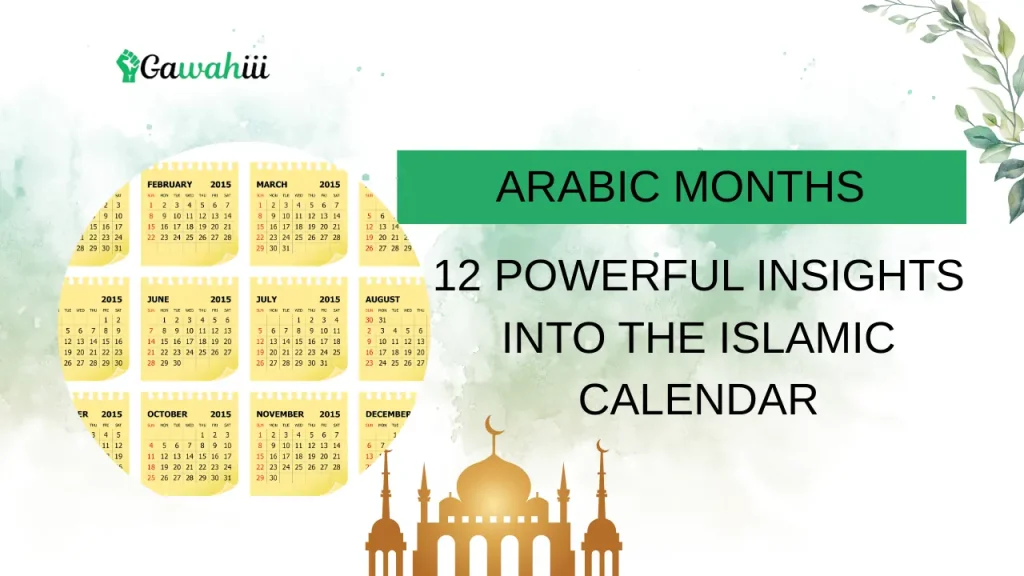Introduction
Time is something that remains the same, but its measurement is often different in other cultures. The Islamic or Arabic calendar is one of the most noteworthy because it follows the pattern of lunar months. For those who wish to know more about Islamic culture, events, or history, knowing Arabic months is necessary. In a world where cultures are easily connected, exploring these months improves our cultural understanding and is necessary for those involved in the Islamic world.
This article gives a full overview of the Arabic months. Each month’s name, origin, and meaning will be looked into, including any key events that occurred in that particular month. You can find out about Ramadan, discover the timing of Hajj, and see how the Islamic year is organized in this guide.
Overview of the Arabic Calendar
The Arabic calendar, known as the Hijri calendar, consists of 12 lunar months in a year that is 354 or 355 days long. It started in 622 CE, when Prophet Muhammad (PBUH) and his companions left Mecca and moved to Medina.
Key Features:
- Lunar-based: The sighting of the new moon represents the beginning of every month.
- The Jewish calendar is about 11 days shorter than the Gregorian calendar.
- This is used mostly for Islamic ceremonies and festivals.
Structure:
- 12 months in total.
- The number of days in every month can be 29 or 30, but never more than that.
- There are no corrections made for the solar year when it comes to the lunar months.
Importance:
- Establishes important Islamic events like the months of Ramadan, Hajj, Eid al-Fitr, and Eid al-Adha.
Muharram: The Sacred Beginning
In the Islamic calendar, Muharram is the first month and is considered one of four months when fighting is not allowed.
Significance:
- Second holiest month after Ramadan.
- As far as Muslims are concerned, the Day of Ashura (10th Muharram) is observed differently by Sunni Muslims as well as Shiites.
Key Facts:
- Named “Muharram” meaning “forbidden.”
- People mark Day of Ashura to remember the death of Imam Hussain (RA) in Karbala.
- Time spent fasting and thinking about one’s actions.
Spiritual Practices:
- Fasting for two days, which are the 9th and 10th (or 10th and 11th) of Muharram.
- Increased prayer and charity.
Safar: Month of Movement
Safar is the second month as it appears in the Arabic calendar. Back then, Arab tribes would often go out on journeys for trading purposes and other reasons.
Etymology & History:
- Travel is referred to as “moving without society” because people are rarely present during it.
- Although some considered it unlucky, God forbids Muslims to hold such beliefs in Islam.
Cultural Aspects:
- Usually, this month is not associated with many religious events or activities.
- Suitable for transport and business when building histories.
Modern Interpretation:
- Encouraged not to follow myths but to follow rational technology.
- A good time for personal development and planning out your day.
Rabi al-Awwal: The Month of Birth
Rabi al-Awwal matters a lot because it is the month when Prophet Muhammad (PBUH) was born.
Key Events:
- Mawlid al-Nabi (the Prophet’s Birthday).
- The 12th of Rabi al-Awwal is the day that this holiday is marked in many Muslim lands.
Observances:
- Religious gatherings and lectures.
- Helping people in the community.
Etymology:
- Rabi refers to spring, which suggests the season for freshness and new growth.
Rabi al-Thani: Continuation and Reflection
Rabi al-Akhir is also the name given to the fourth month in the Islamic calendar.
Themes
- A continuation of the spiritual momentum from Rabi al-Awwal.
- Emphasis on personal development and religious learning.
Historical Notes
- In this month, many important Islamic scholars and leaders came into the world.
Activities
- Studying the life and teachings of the Prophet.
- Attending religious study circles.
Jumada al-Awwal: Harsh Realities
Every year, this month happened at the same time as the dry season in the Arabian Peninsula.
Etymology
- Jumada means dry or parched.
Themes
- A reminder that going through hard times is part of life and strengthens us.
- Time for introspection and building inner strength.
Cultural Significance
- Reflects environmental and social conditions of pre-Islamic Arabia.
Jumada al-Thani: Growth Amid Adversity
Jumada al-Akih is the month that continues to focus on steadiness and focus.
Spiritual Themes
- Overcoming obstacles with faith.
- Acknowledging the blessings hidden in hardship.
Historical Events
- Various battles and treaties took place during this time.
Modern Lessons
- Encourages adaptability and patience in daily life.
Rajab The Month of God
Rajab is recognised as a sacred month and is very important religiously.
Importance
- Time for purification and spiritual preparation for Ramadan.
- Believed to be the month in which the Prophet’s night journey (Isra and Mi’raj) occurred.
Practices:
- Increased supplication and reflection.
- Voluntary fasting is recommended.
Etymology:
- “Rajab” means “to respect” or “to honor.”
Sha’ban The Forgotten Month
Sha’ban is the 8th month and lies in between Rajab and Ramadan.
Significance:
- The Prophet (PBUH) fasted more in Sha’ban than any other month besides Ramadan.
- Night of Bara’ah (mid-Sha’ban) is considered special in some cultures.
Spiritual Focus:
- Time to increase worship and seek forgiveness.
- Preparation for Ramadan.
Modern Relevance:
- Opportunity to build routines before Ramadan begins.
Ramadan to Dhul-Hijjah: A Brief Comparison Table
| Month | Key Feature | Major Observance | Spiritual Focus |
|---|---|---|---|
| Ramadan | Month of fasting | Laylat al-Qadr, Fasting | Self-discipline, Revelation |
| Shawwal | Celebration of Eid al-Fitr | Eid al-Fitr | Gratitude, Renewal |
| Dhul-Qi’dah | Sacred month of peace | Pre-Hajj period | Tranquility, Preparation |
| Dhul-Hijjah | Hajj and Eid al-Adha | Hajj, Eid al-Adha | Sacrifice, Pilgrimage |
FAQs About Arabic Months
1. Why are Arabic months based on the moon?
To be in synch with nature and movement among nomads, the Islamic calendar follows the phases of the moon.
2. Do Arabic months align with Gregorian months?
Because each lunar cycle is about eleven days shorter, the months of the Arabic system will move by around eleven days from one Gregorian year to the next.
3. Are Arabic months used for official purposes today?
This happens mainly in Islamic countries for both religious and civil purposes.
4. How is the start of an Arabic month determined?
Generally, what is used to determine the date for Ramadan is seeing the new moon, except in some countries that rely on astronomy.
5. What’s the most important Arabic month?
Many regard Ramadan as the most significant because of fasting as well as the spiritual importance attached to it.
Conclusion:
Getting familiar with the Arabic months is more than just education, as it takes you on a path through the past, beliefs, and traditions of the Islamic world. Muslims rely on these months to organise their everyday religious activities as well as important once-a-year pilgrimages. Whether you’re a student, traveler, or a curious learner, familiarizing yourself with the Arabic months enriches your appreciation of Islam’s profound and structured timekeeping system.
Feel free to learn more about why each month is special and make sure your calendar marks down these important days of inspiration and reflection. Look into, understand, and celebrate traditions based on the lunar phases of the Arabic calendar.
Reference and source
- IslamicFinder.org
- Al-Islam.org
- Britannica: Islamic Calendar
- Quran and Hadith References
- Historical records from early Islamic scholars
- Also rea this:
- part







